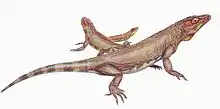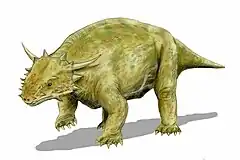Nyctiphruretidae
Nyctiphruretidae is an extinct family of hallucicranian parareptiles known from the late Early to the late Middle Permian of European Russia and south-central United States.[1]
| Nyctiphruretids Temporal range: Early-Middle Permian, | |
|---|---|
| Scientific classification | |
| Domain: | Eukaryota |
| Kingdom: | Animalia |
| Phylum: | Chordata |
| Class: | Reptilia |
| Clade: | †Parareptilia |
| Order: | †Procolophonomorpha |
| Node: | †Ankyramorpha |
| Suborder: | †Procolophonia |
| Clade: | †Nyctiphruretia Lee, 1997 |
| Family: | †Nyctiphruretidae Efremov, 1938 |
| Genera | |
Nyctiphruretidae was named by Efremov in 1938. The type genus is Nyctiphruretus known from several Middle Permian locations in European Russia. Michael S. Y. Lee in 1997 placed the family in the larger clade Nyctiphruretia. The order was defined to include both nyctiphruretids and nycteroleterids.[2] However, recent cladistic analyses suggest that nycteroleterids are more closely related to the Pareiasauria instead, thus making Nyctiphruretus the only genus of its order.[3][4] In 2014, MacDougall & Reisz described and named a second genus of Nyctiphruretidae, Abyssomedon, from the middle Leonardian stage of the late Early Permian of Comanche County, Oklahoma, south-central United States. It contains a single species, A. williamsi, which represents the first nyctiphruretid known from North America, and the oldest species of the family.[1]
Phylogeny
Before the discovery of Abyssomedon, all phylogenetic analyses including Säilä (2010) and Tsuji et al. (2012) recovered Nyctiphruretidae, which was represented solely by N. acudens, as the sister taxon of Procolophonia.[3][4] However, the addition of Abyssomedon by MacDougall and Reisz (2014) to an updated version of the Tsuji et al. (2012) data-set, recovered a monophyletic Nyctiphruretidae, nested within Procolophonia as the sister taxon of Procolophonoidea - a clade formed by owenettids and procolophonids. The following cladogram is simplified after the phylogenetic analysis of MacDougall and Reisz (2014) and shows the placement of Nyctiphruretidae within Parareptilia. Relationships within bolded terminal clades are not shown.[1]
| Parareptilia |
| ||||||||||||||||||||||||||||||||||||||||||||||||||||||||||||||||||||||||||||||||||||||||||||||||
References
- Mark J. MacDougall and Robert R. Reisz (2014). "The first record of a nyctiphruretid parareptile from the Early Permian of North America, with a discussion of parareptilian temporal fenestration". Zoological Journal of the Linnean Society. 172 (3): 616–630. doi:10.1111/zoj.12180.
- M. S. Y. Lee (1997). "Pareiasaur phylogeny and the origin of turtles". Zoological Journal of the Linnean Society. 120: 197–280. doi:10.1111/j.1096-3642.1997.tb01279.x.
- Laura K. Säilä (2010). "The phylogenetic position of Nyctiphruretus acudens, a parareptile from the Permian of Russia". Journal of Iberian Geology. 36 (2): 123–143. doi:10.5209/rev_JIGE.2010.v36.n2.2. ISSN 1698-6180.
- Linda A. Tsuji, Johannes Müller and Robert R. Reisz (2012). "Anatomy of Emeroleter levis and the Phylogeny of the Nycteroleter Parareptiles". Journal of Vertebrate Paleontology. 32 (1): 45–67. doi:10.1080/02724634.2012.626004.






